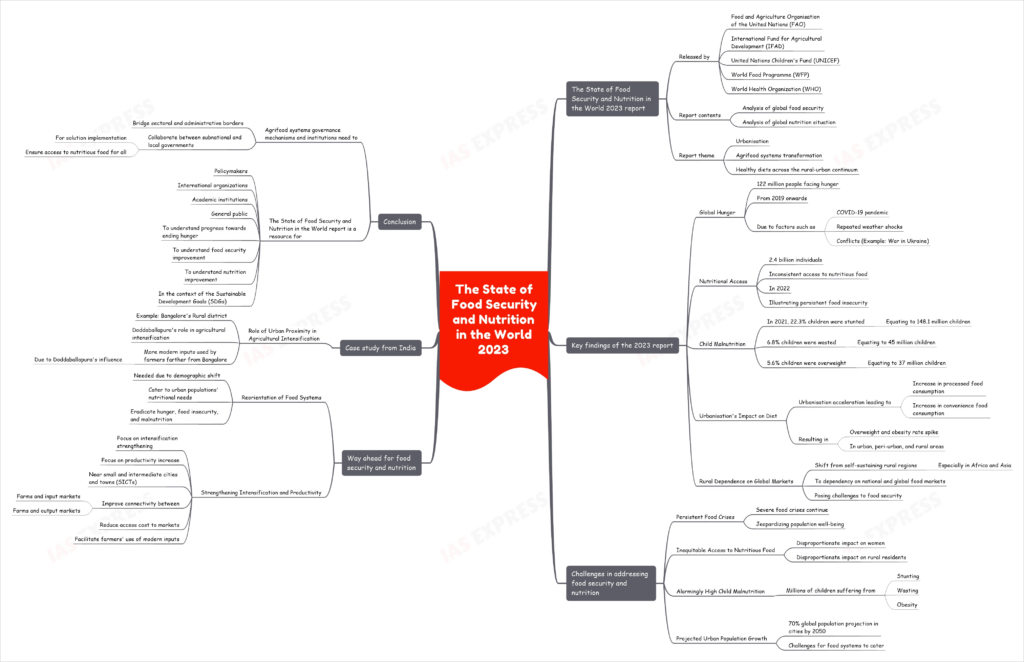The State of Food Security and Nutrition in the World 2023

The State of Food Security and Nutrition in the World 2023 report, released by the Food and Agriculture Organisation of the United Nations (FAO), International Fund for Agricultural Development (IFAD), United Nations Children’s Fund (UNICEF), World Food Programme (WFP), and World Health Organization (WHO), provides an in-depth analysis of the global food security and nutrition situation. The report focuses on the theme “Urbanisation, agrifood systems transformation, and healthy diets across the rural-urban continuum.” This article will discuss the key findings of the report and the challenges and the way ahead in addressing food security and nutrition issues worldwide.

This topic of “The State of Food Security and Nutrition in the World 2023” is important from the perspective of the UPSC IAS Examination, which falls under General Studies Portion.
Key Findings of the 2023 Report
The report highlights several critical findings regarding global hunger, nutritional access, child malnutrition, and the impact of urbanisation on diet. These findings shed light on the current state of food security and nutrition worldwide:
- Global Hunger
- Over 122 million people have been facing hunger since 2019 due to various factors, including the COVID-19 pandemic, repeated weather shocks, and conflicts such as the war in Ukraine.
- Nutritional Access
- Approximately 2.4 billion individuals did not have consistent access to nutritious, safe, and sufficient food in 2022, emphasizing the persistent issue of food insecurity.
- Child Malnutrition
- In 2021, 22.3% (148.1 million) of children worldwide were stunted, meaning they were too short for their age.
- 6.8% (45 million) of children were wasted, indicating they were too thin for their height.
- 5.6% (37 million) of children were overweight, highlighting the rising problem of obesity among children.
- Urbanisation’s Impact on Diet
- With the acceleration of urbanisation, there has been a noticeable increase in the consumption of processed and convenience foods.
- This shift in dietary patterns has resulted in a spike in overweight and obesity rates across urban, peri-urban, and rural areas.
- Rural Dependence on Global Markets
- Previously self-sustaining rural regions, particularly in Africa and Asia, are becoming increasingly dependent on national and global food markets.
- This reliance on external markets poses challenges to food security and nutrition in these areas.
Challenges
While there have been some improvements in global hunger numbers between 2021 and 2022, numerous regions still face deepening food crises. The report identifies the following challenges in addressing food security and nutrition:
- Persistent Food Crises
- Many places around the world continue to experience severe food crises, jeopardizing the well-being of their populations.
- Inequitable Access to Nutritious Food
- Women and residents of rural areas are disproportionately affected by inadequate access to nutritious, safe, and sufficient food.
- Alarmingly High Child Malnutrition
- Child malnutrition rates remain alarmingly high, with millions of children suffering from stunting, wasting, or obesity.
- Projected Urban Population Growth
- By 2050, it is projected that 70% of the global population will reside in cities, posing significant challenges for food systems to cater to these urban populations.
Way Ahead
Addressing the challenges and ensuring food security and nutrition for all requires a comprehensive approach. The report suggests the following strategies as a way ahead:
- Reorientation of Food Systems
- Given the significant demographic shift towards urban areas, food systems need to be reoriented to cater to the nutritional needs of urban populations and eradicate hunger, food insecurity, and malnutrition.
- Strengthening Intensification and Productivity
- Policies should focus on strengthening intensification and increasing productivity in farming near small and intermediate cities and towns (SICTs).
- This approach will improve connectivity between farms and input and output markets, reducing the cost of access to markets and facilitating farmers’ use of modern inputs.
Case Study from India – The Role of Urban Proximity in Agricultural Intensification
As a case study, the report highlights the role of urban proximity in agricultural intensification using the example of Bangalore, India. The town of Doddaballapura, located in Bangalore’s Rural district, serves as evidence of the essential role of small and intermediate cities and towns in increasing the use of modern agricultural inputs in rural areas. Farmers located farther from Bangalore show a higher use of modern inputs due to the influence of Doddaballapura.
Conclusion
To effectively address food security and nutrition challenges, agrifood systems governance mechanisms and institutions must bridge sectoral and administrative borders. Collaboration between subnational and local governments is crucial for implementing solutions that can ensure access to nutritious food for all. The State of Food Security and Nutrition in the World report serves as a valuable resource for policymakers, international organizations, academic institutions, and the general public to understand the progress towards ending hunger and improving food security and nutrition in the context of the Sustainable Development Goals (SDGs).

